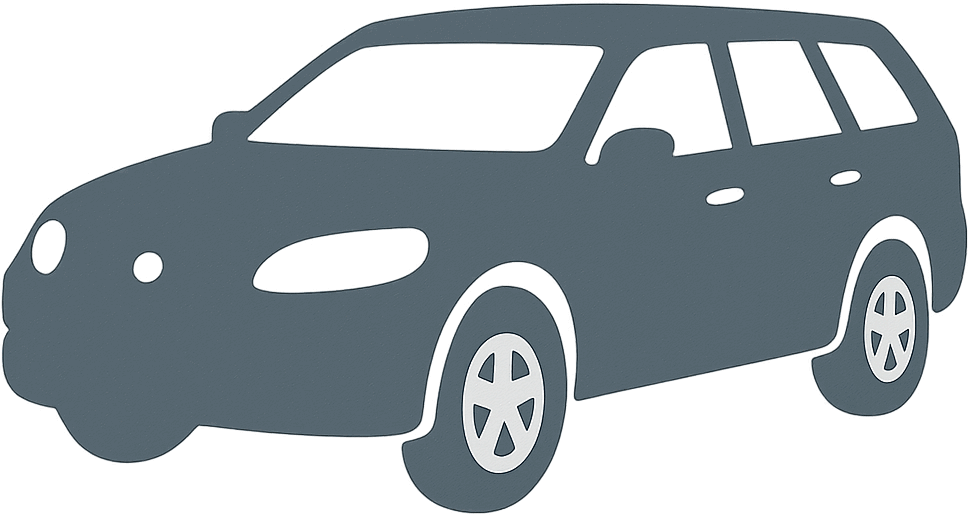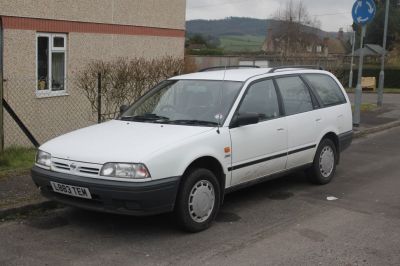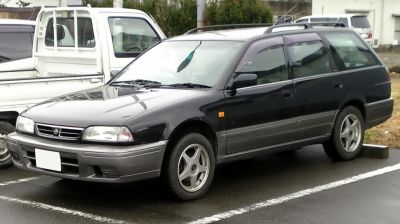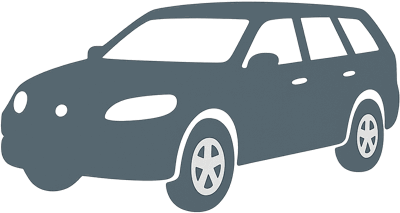 1986 Citroen BX I Break (Phase I, 1986) Dimensions, Size & Specs
1986 Citroen BX I Break (Phase I, 1986) Dimensions, Size & Specs
Measurements of the 1986 Citroen BX I Break, engineered for optimal performance and comfort
| Dimensions | |
|---|---|
| Length: | 4399 mm173.2 in14.4 ft |
| Width: | 1650-1660 mm65.0-65.4 in5.4-5.4 ft |
| Height: | 1431 mm56.3 in4.7 ft |
| Trunk Capacity: | 512 liter18.1 cu ft |
| Trunk Capacity (Max): | 1803 liter63.7 cu ft |
| Weight Specifications | |
| Curb Weight: | 940-1037 kg2072-2286 lbs |
| Maximal permitted Weight: | 1445-1580 kg3186-3483 lbs |
| Tire Specifications | |
| Rims Size: |
|
| Tire Size: |
|
The Citroen BX I Break (Phase I), introduced in 1986 and produced from 1985 to 1986, represents the station wagon variant of the popular BX model line. This mid-1980s vehicle is designed to offer compact practicality with a distinctive French automotive style. The BX I Break measures 4399 mm (173.1 inches) in length, making it a well-sized station wagon suitable for urban and suburban use while still providing ample interior space.
The vehicle's width ranges between 1650 mm (65.0 inches) and 1660 mm (65.4 inches), paired with a height of 1431 mm (56.3 inches), creating a balanced profile that enhances maneuverability without sacrificing cabin comfort. With a curb weight varying from 940 kg to 1037 kg (2072 to 2285 pounds), the BX I Break is relatively lightweight for its category, positively impacting fuel efficiency and handling.
One of the standout features of the BX I Break is its versatile luggage capacity. The standard boot space offers 512 liters (18.1 cubic feet), which can be impressively expanded to 1803 liters (63.6 cubic feet) when the rear seats are folded down, catering well to families and those requiring substantial cargo space. The vehicle rides on 14-inch rims equipped with 165/70 R14 tires, which contribute to its stable ride quality and road grip.
Overall, the Citroen BX I Break (Phase I) combines compact exterior dimensions with practical luggage capacity and efficient weight distribution, making it a compelling choice for drivers looking for a station wagon with classic 1980s French design and functional versatility.
Discover the standout features that make the 1986 Citroen BX I Break a leader in its class
Have a question? Please check our knowledgebase first.
The Citroën BX I Break (Phase I, 1986) has a length of 4399 mm (173.1 inches), width ranging from 1650 mm to 1660 mm (64.96 to 65.35 inches), and a height of 1431 mm (56.3 inches). These dimensions give the station wagon a compact but practical size suitable for urban and suburban use, allowing for good maneuverability while still providing ample interior space.
The BX I Break (1986) succeeded the Citroën GS and GSA station wagons. Compared to the GS Break, the BX I Break is generally longer and wider, offering more interior space and a more modern design. The length of 4399 mm and width of about 1650-1660 mm mark an incremental growth in size relative to its predecessor, improving passenger comfort and luggage capacity while retaining Citroën’s signature compactness for easy city driving.
The Citroën BX I Break has a curb weight ranging between 940 kg and 1037 kg (2072 to 2285 lbs), with a maximum weight between 1445 kg and 1580 kg (3187 to 3483 lbs). These weights contribute to a relatively light vehicle, which helps with fuel efficiency and agile handling. The lightweight is partly due to the car's design focus on economy and practicality, ensuring it remains competitive as an efficient station wagon in the mid-1980s market.
The BX I Break offers a standard luggage capacity of 512 liters (18.1 cubic feet) with the rear seats in place, making it quite practical for everyday use such as grocery runs or luggage storage. When the rear seats are folded down, cargo space expands significantly to 1803 liters (63.6 cubic feet), accommodating larger items like furniture or bulkier gear, which is ideal for families or those needing high versatility in their station wagon.
Yes, the Citroën BX I Break, with its moderate length of 4399 mm and width up to 1660 mm, fits comfortably into a standard garage. Typical residential garages range from about 2400 mm to 2700 mm wide (94.5 to 106 inches) and upwards of 4800 mm long (189 inches), which provide ample space for the BX I Break to park with sufficient clearance on all sides, making it convenient for everyday use and storage.
The Citroën BX I Break is equipped with 14-inch rims fitted with 165/70 R14 tires. This tire size strikes a balance between ride comfort and handling stability. The relatively narrow width of 165 mm helps reduce rolling resistance and improves fuel economy while offering sufficient grip for typical 1980s vehicle speeds. The 70% aspect ratio contributes to a comfortable ride by providing some sidewall cushioning over bumps and road irregularities.
With a width between 1650 mm and 1660 mm (around 65 inches), the Citroën BX I Break is relatively narrow compared to modern station wagons but fairly typical for its era. This width allows for sufficient interior shoulder room for four passengers, while also making the car easier to navigate through narrow streets and tight parking spots. The modest road presence helps in urban environments but still provides a stable driving experience on highways.
The Citroën BX I Break's height of 1431 mm (56.3 inches) is relatively low for a station wagon, contributing positively to the car's aerodynamic profile. A lower height reduces air resistance, helping improve fuel efficiency and stability at speed. It also makes for easier ingress and egress and lowers the center of gravity, enhancing handling. However, the lower height may slightly reduce headroom compared to taller wagons, but the BX's design is generally well balanced for passenger comfort.
In the mid-1980s, the Citroën BX I Break stood out for its compact yet spacious design. Compared to similar mid-size European station wagons like the Peugeot 305 Break or Renault 18 Break, the BX was generally more compact in width but comparable in length and height. Its lightweight construction and efficient layout provided good fuel economy and practicality. The generous cargo capacity of up to 1803 liters with seats folded offered competitive flexibility, making it an appealing choice for drivers prioritizing a balance between city driving agility and cargo space.
At a curb weight range between 940 kg and 1037 kg (2072 to 2285 lbs), the Citroën BX I Break is relatively lightweight for a station wagon. This low weight positively impacts fuel economy by requiring less energy to move the vehicle, making it more economical during everyday use compared to heavier wagons. Additionally, the lighter weight improves driving dynamics, enabling the BX I Break to remain nimble and responsive, particularly helpful on varying road conditions. The balance between moderate weight and structural robustness also supports steady handling, contributing to a safe and enjoyable driving experience.
Discover similar sized cars.

| Production: | 1990-1998 |
|---|---|
| Model Year: | 1990 |
| Length: | 4460 mm175.6 in |
| Width: | 1695 mm66.7 in |
| Height: | 1500 mm59.1 in |

| Production: | 1991-1998 |
|---|---|
| Model Year: | 1991 |
| Length: | 4460 mm175.6 in |
| Width: | 1695 mm66.7 in |
| Height: | 1490 mm58.7 in |

| Production: | 1990-2001 |
|---|---|
| Model Year: | 1990 |
| Length: | 4472 mm176.1 in |
| Width: | 1695 mm66.7 in |
| Height: | 1500 mm59.1 in |

| Production: | 1990-1996 |
|---|---|
| Model Year: | 1990 |
| Length: | 4472 mm176.1 in |
| Width: | 1695 mm66.7 in |
| Height: | 1500-1540 mm59.1-60.6 in |

| Production: | 1969-2004 |
|---|---|
| Model Year: | 1969 |
| Length: | 4410 mm173.6 in |
| Width: | 1635 mm64.4 in |
| Height: | 1435 mm56.5 in |

| Production: | 1983-2006 |
|---|---|
| Model Year: | 1984 |
| Length: | 4391-4410 mm172.9-173.6 in |
| Width: | 1615-1660 mm63.6-65.4 in |
| Height: | 1460 mm57.5 in |

| Production: | 1984-1998 |
|---|---|
| Model Year: | 1985 |
| Length: | 4404 mm173.4 in |
| Width: | 1636 mm64.4 in |
| Height: | 1455 mm57.3 in |
